Thought Exercises
now browsing by category
Blog 5: Masterpost McGonigal
A Field of Links- By Julia McGonigal
I’m planning on taking an ASL class while at SDSU. I would love to become fluent but it might be a bit hard if this is true
My parents have always pushed me to learn a language besides Spanish, and every time they do I like to pull out this bad boy !
I’ve always heard that once you speak one latin based language you can learn others easily.
Who know’s if that’s true though? It always seems that languages can be easily learned when you are a baby, not as a young adult
Another suggested language that was suggested for me to try and learn is computer programming language. It seems a bit challenging to me, but I think it could be really cool if I was learning stuff like this
I love that movie Avatar, and I’m totally going to geek out here but there’s tons of different ways to learn the language!
I’ve been trying to figure out if the language itself could be taught as an elective, I’m pretty sure some people have attempted it…
But I mean I know that the individuals who created the Na’vi language studied many different linguistic aspects
Some even go so far as to figure out the specific phonology of the language!
But enough about the already existing Na’vi language…I think it would be interesting to see what goes into developing your own language
It’s the strangest blog I’ve ever found…and yet it is extremely fascinating. I think if I were to create my own language it would just be a bit of confusion.
The best thing for me to do is to find a language that I find interesting, and follow a passion. In this case it’s definitely going to be the Na’vi language! And here’s how I’m going to learn it
LFL: hummmmm strange
About Me. under graduate a senior a prototype of linguist hoping to graduate soon.
My linguistic self. i am a straight muslim mixed man from bay area. I’m well founded in islam some say i am religious some and i say i am not. i guess you could say i am religious. i use my language some ways theatrically, with a lot of no practicing muslims or the ones who claim to be religious with a variation of volume and pitch hmmmm think like the eminent sheikh ibn quadmah may Allah have mercy upon him. i used to pronounce words like “turn” and “churn” i don’t recall of any other words i would miss pronounce.
My Favorite Books. my favorite books would include umdatah fiqh,umdatah akham,sharh sunnah, quran, mughani, hadith sunnah nasi, bukhari, muslim and many others it would cover my whole page if i would keep adding books.
My Favorite Word. I think that “like of” i think is perfect word in English ( i think it is just english). it describes for example when quoting a quote of the individual and you say the word it feels like you are not plagiarizing and i like the sound of the word. it starts out sssss – ffffff making it explosive but soothing and not harsh. after all this does sometimes happens to me. its an old farsi dialect.
How is linguistics like a pine cone? although pine cone has scales i would say it is a pine cone based on how many scales it has
LFL: Student, Athlete, Linguist, do-gooder

About me:
I was born and raised in Minneapolis, MN. I speak both English and Swedish. I play hockey and soccer. Die hard Wild fan.
My Language:
I’m a middle class white male from Minneapolis, MN. I am an artist and athlete. I lived in Sweden for a year. I picked up the language very quickly and became nearly fluent. Since this time I’ve lost a lot of my vocabulary but have maintained a good ability to understand and communicate in Swedish. I’ve been back several times to visit family and friends.
Favorite Music:
I can listen to anything depending on time place and mood. I love live hip-hop concerts. I also like to listen to indie-type music. Fink, Bombay Bicycle Club and Cage the Elephant are primo.
Favorite Word: Lagom
This is a Swedish word that means “Middle” or “Moderate” or “Just right”. The word doesn’t translate directly into English because it is used differently. I like the word because it describes a lot of the things well. I’m feeling lagom: relaxed, content, good.
Ideal Linguistic Adventure:
I meet a cute Swedish blonde girl. We alternate from speaking Swedish and English. We date for a few months. She wants me to meet her billionaire parents. I fly into Stockholm in a private jet and meet her parents at their mansion. Her mother speaks Swedish and French. Her dad offers me an executive position at his graphic design firm in France. The mother teaches me French and I soon become fluent in both French and Swedish.
How is linguistics like a pine cone?
Linguistics is hard. It’s a spiky and rough on the outside. But pine cones come from trees; there is a larger meaning and use. Linguistics is complex but paramount to our understanding of the world.
LFL: Fun, Eccentric Non-conformist
 Something About Myself: Extremely lazy but work well under pressure; enjoy baking at own leisure. Bed must be neat and tidy… and surrounded by stuffed animals.
Something About Myself: Extremely lazy but work well under pressure; enjoy baking at own leisure. Bed must be neat and tidy… and surrounded by stuffed animals.
My Language: I am originally from a small village in China, then traveled to a small city in Los Angeles called San Gabriel, which is still filled with my own kind- Asians. I consider myself to be a dorky Asian rebel that still goes to the temple with my mom every year. I tend to talk very fast with my close friends, which are also Asians. Also, I often slur my words simply because I am too lazy to enunciate every word.
Favorite Movies: 1) White Chicks
2) A Walk to Remember
3) Death at a Funeral
Favorite Word: Dumpling. A simple word that sounds cute and delicious. The outside may seem plain and boring, but as you bite into it, you will taste different kinds of yummy-ness.
My Ideal Linguistic Adventure: We would be walking down a crowded street in Paris speaking French and enjoying dessert at a cute coffee shop. Then we would be in an isolated island in Japan enjoying nature and listening to the natives speak Japanese.
How is Linguistics like a Pine Cone? A pine cone is defined as: the conical or rounded woody fruit of a pine tree, with scales that open to release the seeds. Linguistics is similar in the sense that there are many branches and categories. Pine cones contain the reproductive structure of a pine tree, while Linguistic Reproduction plays a major role in the evolution of language groups.
LFL: Order out of Chaos
About Me
 (Matrix Reloaded using an actual exploit)
(Matrix Reloaded using an actual exploit)
I have to find out “the hard way”. I’m a former psychonaut not by choice. People I look up to are hackers, chemists and professors.
My Language
 (representation of Indra’s net)
(representation of Indra’s net)
I’m a Caucasian from San Diego, California. I’m a yellow belt in Shaolin Kempo. I have friends that I’ve met online that I’ve spoken to through free (for us) conference lines. When I’m discussing philosophy with a friend I find I can convey the concepts best through metaphors like Indra’s Net when discussing the interconnectedness of reality. I also use language differently depending on who can hear within the range of my voice.
Favorite Movies
 ( from Nausicaa)
( from Nausicaa)
The Matrix – Wachowski siblings
Gozu – Takashi Miike
Nausicaa – Hayao Miyazaki
Favorite Word
Puppet is my favorite word and I love to use it around people whose only source of news comes filtered through fox or msnbc and its related affiliates. Puppet is such a childlike concept that can induce such rage in someone deeply amuses me.

Here’s an example, The US government went to Central and South America and destabilized governments through various coup d’état in which they installed a Puppet dictator whose strings could be pulled by the CIA in Washington.
Sanskrit Adventure
(is said to be the sound of the first utterance of the universe)
My ideal linguistic adventure would consist of a Brahmin fluent in Sanskrit who would break down the words into morphemes so that with his guidance we could could form phonemes giving me access to ancient texts which contain a well’s worth of wisdom and knowledge. Eventually after studying with him for many years my phonology would pick up the words near fluency.
Pinecone
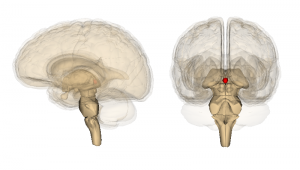 (a computer model representation of the pineal gland)
(a computer model representation of the pineal gland)
Linguistics is like a pinecone because it’s strength lies at the foundation like that of the language families similar to a tree. These trees can be found in linguistics like the “Indo-European” family which breaks down at least partially into the Germanic branch. The pinecone also represents the pineal gland within the sphere of linguistics in addition to a lot of interdisciplinary studies which try to define its one specific use but like linguistics its not entirely fleshed out and to say it is would place limitations on it. There is even the pinecone looking quite similar physically to the pineal gland or as Descartes’ put it “the seat of the soul”.
Hw 4
Carl Spencr, Katrina Chavez, Paige Bowden, Michelle Kuerz
Language is ever changing, it is constantly evolving and taking new forms. The world is filled with thousands of languages, each one unique to its’ own culture, having different rules and social norms. Language and culture go hand in hand. If you are a native speaker of a language you will automatically have a mental grammar and cultural competence. If you are a speaker of Pidgin, then you will take the very basics of a language and build from there. Language can be broken down and changed, and it also holds cultural context. Language, not only is expressed in words, but in numerous things such as culture, body language and history. It is in a state of constant change, molding and shaping generations through generations, from odd and mixed beginnings to the way we need to use it today. Its been around for thousands of years and there is no such thing as a ‘standard language.’ Language changes slowly. Almost unnoticeable. By the time people do notice it, it is already to late. Language is one of the main things that defines us. It was makes us so special and unique. It is what makes us who we are.
P.445 #16
a.Non native b. Natural c. Non d. Some e. Some f. Natural g.Natural/Some h. Some I. Natural
J. Natural k.Natural l.Non m. Some n. Some o. Some
P.446 #17
a. A b. A c. E d. other, Cola e. A f. B g.A h. C I. None
Pg. 444 #14
P, S, Ph, Sm, M, Ph
Pg. 445 # 16
-Non- native
-Natural
-Some
-Natural
-Some
-Non- Native
-Some
-Natural
-Non- Native
-Natural
-Non-Native
-Some
-Natural
-Some
-Non-native
Pg. 446 #17
1.bucket
2.bag
3.blinds
4.soda
5.fireflies
6.in line
7.straighten it up, clean it up
8.you guys
9.a quarter to 5, a quarter til 5
P.444 #14
1.Phonetic, has to do with the individual sounds
2. Syntactic, choice of words to form a sentence (structure)
3.Phonetics, has to do with speech sound
4.Semantics, word meaning
5.Morphological, smallest unit with meaning (affixes)
6.Phonetic, speech sound variation
P.445#16
1.Non-native b. natural c. non-native d. some e. some f. some g. some h. some i. some j. natural k. non-native l. some m. some n. some o. non-native
P.446 #17
1.A b. A c. A & E d. A e. A f. B g. D h. A i. B
p. 444, #14 – Identify the level of linguistic structure where the variation occurs.
1. P
2. S
3. PH
4. SM
5. M
6. PH
p. 445, #16 – Natural, Some, Non-Native
a. non native
b. Natural
c. Some
d. Some
e. Some
f. Some
g. Natural
h. Some
i. Some
j. Natural
k. Some
l. Some
m. Natural
n. Some
o. Non-native
p. 446, #17- Vocabulary variation
a. bucket
b. bag
c. curtains
d. soda
e. lightening bugs
f. in a line
g. clean it up
h. you guys
P.479 #1
Using politeness where it is fit, (culturally, situationlly, contextually) Attentiveness to your speaker and as a listener yourself, to what is being said, social cues, expressions, timing etc and overall interaction with your partner.
P.479 #2
Culturally some languages require a certain way of speech such as Japanese with it’s 謙譲語 and 尊敬語 which could be seen as a separate dialect as you switch your verbal tone entirely from it. Words conjugation entirely differently with the these forms. Physical practices too, outside of verbal communication can rely respect and politeness.
P.479 #3
1.How are you?//I’m good, yourself? 2.How was class?//Pretty good 3.Sleep well?// Yeah.
4.You hungry?// Nah, Im good. 5. Want a drink?//Yeah sure.
P.480 #15
It can be established by basic techniques of compliance, being of an already higher ground of authority, tone of voice, generating interest; negatively it can also be forced, coerced.
For example, I’m actually more of a soft powered person in relation to authority, at my work, I’m in charge of 15 or so children week to week, whereby I’ve tended to use a sort of soft power to persuade or establish an authority. As in, if the 15 or so kids get out of control, while yelling or whistle blowing to get their attention works, if you get the children who already listen to calm down, and either compliment or praise or reward them, the other kids might also want the rewarding and begin to calm down.
p. 482,
#28
a. Etic- Susie passed by me in the Starbucks over on Washington street. She gave me a big hug and we each took turns exchanging stories while waiting in line. Emic- I saw susie today in Starbucks
b. Etic- I sat down along side the brick wall next to the library. I opened my back and pulled out a peanut butter and jelly sandwich along with some carrots. I reached for my ipod inside my pocket and turned on Pandora radio. Emic- I ate lunch near the library.
c. Etic- The instructor started class at exactly 8 am, he said “ok lets get started” and began reviewing last lessons material on Acoustics. He began with the last slide we ended off on which was cochlear mechanics. He then asked the class if anyone had any questions. Emic- He came in and started lecture right away.
#29
Passive observation- acting as a bystander observing surroundings
Participant observation- Actively observing surroundings in order to learn more.
Pg. 557
#10
We know about proto-Germanic or that there was one because that is where we get English. Germanic is the mother of English. Also, all though there are not any written records of the language, we can still proved it existed because of words and grammar that are similar in other languages.
#14
We spell it with a <k> sound even though we no longer pronounce it that was is because a long time ago, we actually did say the k. some parts of the world still don’t, we just dropped it a while ago.
Pg. 561
#22
One example is for draw. For past tense it can be drew or drawn.
Pg. 562 #29
- computer jargon is in itself its own language. Because of the more recent development of computers (only over the past 25 years), a lot of the terms are new (for example: Googling). However, most of the terms are English words used in new ways (For example: a mouse, before computers it only meant a rodent, but since computers it means the object you use to scroll and click). Like I said, because computers are a more recent development, we are just starting to add to the language completely invented by the digital age, most words are just recycled.
ii It seams a semantic expansion is occurring with the use of already existing
English terms. The example given, “surf the net,” consists of words that already made sense in English, but because of computers, these words take on a new meaning. This seems to be the case because the word meanings are simply reinvented from previously existing words.
Pg. 563 #33
- cynic – like a dog, extension
- hacker – someone bad at a sport, extension
- anecdote – unpublished items, reduction
- grotesque – cave painting, extension
- parakeet – parrot, reduction
- leer – cheek, extension
- captivated – to take, extension
- paisley – town in Scotland, extension
Pg. 513 #12
As an English speaker, I feel that borrowing words from another language does not harm that language at all. However, English is a language and culture that prides itself on being a melting pot of many other cultures, so I may be a bit biased. As far as the French trying to preserve their language, I think that is ridiculous. Language is supposed to be in a constant state of change, which is the very reason we do not speak Old English today. Adding words from other languages to your own language only enriches it and adds more options for word choice. I do not see how this could be a bad thing.
Pg. 516
#22
Once upon a time there was …. Anansi and…TIger. So now, in a …. you want to tell you? In a ….? So now………….. So now….. Anansi, you know how him trick already….I tell Tiger make them go pick…….. So now Tiger say, “Okay then lets go,”……..
Once upon a time to start a story is similar to English. So now represents next. Differences include direct speech to the audience, and incorrect use of pronouns.
#23
Hukilepo, get many people on this island who stay think me I ought to been some [] hospital. But me, I going tell you something….One [] been tell the other one to go buy ice cream for they eat up on top the bus. Then the other one [] like go so he been say, “[] money.” What’s the matter with him. he can no say, “Me I stay broke?”
Use of the first person, Incorrect use of pronouns according to English. No contractions, just omission.
Pg. 517 #29
Every language has a culture that goes with it. To completely let all Native American languages die is to wipe out an entire culture as well. From a historical standpoint, we should really be fighting to keep them alive because these languages hold many clues as to just what kind of civilization each tribe was. The least we can do is preserve these languages, especially because we are part of the reason they are dying in the first place. The effort to colonize America completely wiped out the indigenous peoples, and this is last tie that the remaining Native Americans today have to their ancestors
Looking For Linguists: an extra credit opportunity
Hello, Linguists and Members of Various Communities of Practice!
So, a lot of you have been asking for extra credit opportunities. Here’s a great one– you’ve got until Thursday morning’s class to complete it.
One of the most common ways that we display the categories and communities we belong to is through the use of online profiles– your Facebook profile, your OK Cupid profile, your Soundcloud profile, your LastFM or Pandora profile, your Ello profile, your Tumblr profile, your Twitter profile, your LinkedIN profile, and on and on and on…
Your task for these possible extra credit points is to create a profile for the brand-new social meet-up site:
“Looking For Linguists”
Looking For Linguists is a social meet-up site where linguists are paired with non-linguists for language-related adventures. Choose your role– either you’re a linguist or a non-linguist– and create a profile that would encourage someone to pair with you for an adventure.
A couple things all LFL profiles must have:
1.) Tagline: Eleven words or less. Something that would make people searching LFL want to check out your profile. The title of your post will be LFL: [your tagline]
2.) About Me: Up to 140 characters describing who you are, generally (if you’re not sure how many characters 140 is, use this online tool)
3.) My language: Up to 500 characters. Must include– Geographic Region I’m From / Race~Ethnicity / Two Possible Communities of Practice I engage in / Two unique or interesting ways I use language / and optionally, you can include information on your social class or your gender~sexuality.
4.) Favorite Movies or Music (limit yourself to three things)
5.) Favorite Word. — make sure you describe *why* it’s your favorite– don’t just state the word!
6.) Describe your ideal linguistic adventure. Begin with who you’re looking for (be linguistically relevant!)
7.) Answer the question: “How is linguistics like a pine cone?”
8.) Under post “tags” give five words that describe you or your language experiences
9.) Under “categories” choose Pine Cone Linguistics, Thought Exercises, LFL, and Posts
10.) Finally… make sure you upload a profile picture to include! The profile picture should be oriented in the top-left of your post and should be 150 x 150 pixels (use the WordPress image editing tools if you need to change the size of your picture). Set your profile pic as a “featured image” if you want!
Here’s MINE so you can see what these things should look like.
GRADING: Grading will be a trickle-down system– Whoever has the best LFL profile will get the most extra credit points, and so on down the line. So be aware of things like formatting, spacing, use of good tags, appropriate insertion of links, proper formatting of the picture, use of a good (or interesting) picture, etc. After you post, look at your “LFL profile” and make revisions if necessary. And if you see any of your fellow students’ LFL profiles, make sure to comment on them!
Have fun!
-doug
LFL: Language wizard, intellectual agrarian, general bon vivant filled with bons mots.
 About Me. Writer for Lexicon Valley; Linguistics Professor; occasional blogger of comics, dogs, and gay stuff. Still angsty after all these years.
About Me. Writer for Lexicon Valley; Linguistics Professor; occasional blogger of comics, dogs, and gay stuff. Still angsty after all these years.
My Sociolinguistic Self. Sociolinguistically, I’m a gay, white, man from St. Louis, Missouri by way of Austin, Texas. I’m a NERD and a ROCKER (so, maybe just NERDCORE?) and a RADICAL ANARCHO-FEMINIST. I use language very theatrically, with a lot of pregnant………. pauses and a lot of variation in pitch, volume, and speed (think Captain Kirk imitating the Gilmore Girls). I also pronounce words like “pen” and “pin” / “Kim” and “chem” / “gym” and “gem” exactly the same– my KIT and DRESS vowels sound the same before nasal sounds.
Favorite Music. Lately, I’ve been listening mostly to Yalls, Conveyor, and Seamonster.
Favorite Word. I think that “saudade” is the most perfect word in English (and it’s borrowed from Portuguese). It describes the particular kind of sadness or melancholy you feel from remembering the past. Also, I like the mouthfeel of the word. It starts out all oceanic– sssss — aaawwww…. and then crashes in with a big explosive DA and then mellows out again at the end… de.
Describe your ideal linguistic adventure. I’m looking for a fellow polyglot– a real DuoLingo junkie. We’d meet at a bar. You’d speak fluent German and Portuguese while I’d speak fluent French and Spanish. As we sip craft beer into the late afternoon, we’d use no English– just my stammering Germano-Portuguese and your amusing “Esfrangol.” Then we’d take a walk around the park and name everything we can with what little Klingon we both remember. “”sor” means TREE,” you’d say, and I’d laugh and correct you– “actually, it’s Sor.” Then we’d play scrabble or scategories in Russian.
“How is linguistics like a pine cone?” … you tell me!
Morphology of Roy Lichtenstein’s Artwork
- What parts of the image do you see?
1st image: I see a blonde hair woman, tears streaming down a sad woman’s face, a thought bubble, a man in his suit and tie, and a yellow background
2nd image: I see a blonde hair blue eyed woman, tears streaming down a sad woman’s face, a thought bubble, words, and a bed or sofa
3rd image: I see a blonde hair blue eyed woman, a window, a thought bubble, staircase, and words
- How do those parts interact with each other?
1st: Since the man is in the thought bubble, the woman is obviously crying while thinking about him.
2nd: The woman is lying on a bed or sofa crying and thinking about something.
3rd: The woman is sitting beside a window that gazes at the nighttime city thinking about a man.
- Is this image telling a story?
1st: Yes the woman probably thinking about a loved one she’s lost or broke up with
2nd: Yes the woman is crying and thinking about how things should’ve been.
3rd: Yes the woman is wondering about where a man is at, probably a loved one
- Which parts of this image are characters in the story?
1st: The women is character of the story but the man can also be an important character since he’s the cause of the woman’s tears.
2nd: The women is obviously the subject or character of the story
3rd: Just like the previous images, the woman is also the character of the story
- Which parts of this image are crucial for the setting of the story?
1st: Not really a setting except a yellow background but it could probably mean she’s in a brightly lit room.
2nd: There’s not really much of a setting except for the couch/bed the woman is lying on
3rd: The window, night sky and skyscrapers create the background of the picture
- Which parts of this images are crucial for the plot?
1st: The crucial element is the women and the man in the thought bubble because it shows that thinking about the man make her cry.
2nd: The crucial element is the women and the words in the thought bubble because it shows us that she’s crying and regretting something.
3rd: The crucial element is the women and the words in the thought bubble because it shows us that she’s thinking about someone and wondering where he’s at.
- How do these parts interact?
1st: Shows that woman is thinking about a man she loves that has broken her heart
2nd: Shows that a women is lying in bed crying over a relationship probably that should’ve began another way.
3rd: Shows that its late at night woman is probably waiting for her man to come back hoe but he hasn’t come back yet so she’s worried.
- What parts of this image are “root” or “stem” parts and which parts feel like “affixes”? Why?
1st: The root of the image is the woman, the man in the bubble and the tears b/c they are crucial to the plot of the image. The affixes would be the colors, the tiny dots on the characters faces and the bold outlines.
2nd: The woman and her tears are the roots of the image because she’s the main character of the picture and the tears help show the emotion she’s feeling. The words inside her thought bubble is also the stem because it shows us what she’s thinking about that caused her to cry. The affixes would be the bed she’s laying on, the colors and the bold outlines.
3rd: The roots of the image is the woman and the words inside her thought bubble because it shows us that she’s thinking and concerned over someone. The windows, the buildings and the night sky are also the stem because they make up the background and setting of the image. Without it we won’t know that the woman is up late waiting for someone. The affixes would be the staircase, bold outlines, Ben-Day dots and colors because they kind of hold the hold image and brings it together.
- Of the affixes, can you say which are “inflectional” (they only exist to hold the grammar together) and which parts are “derivational” (they add some important information to the meaning, or change the kind of meaning of a given part)?
1st: I think the bold outlines and the Ben-Day dots on the characters faces are derivational. Without them, we’d not be able to see what the image is about because those are what basically make up the picture. The color of the picture however, is inflectional. Without colors, we will still be able to make out the important parts of the image such as the crying woman and the man in the thought bubble. The coloring just adds to the image but doesn’t affect the plot of the image.
2nd: The bold outlines on the picture are derivational because without them, we wouldn’t be able to make out what’s actually in the picture. For example without these black lines we probably won’t be able to tell that’s a woman’s face we’re seeing. Colors again is inflectional it’s just there to tell there to give the audience some extra details such as the woman has blonde hair and blue eyes but those are just minor details not crucial to the plot. The object the woman is laying on also is inflectional, it’s not really part of the background or anything and is just there to give the audience some extra details about the image. Without these inflectional affixes we will still be able to see what the woman is crying about.
3rd: The staircase would be inflectional because it doesn’t really do much to the image doesn’t tell us much about the story of the picture except the woman has a 2 story house. The bold outline, ben-day dots and colors however are what gives meaning to the picture and brings out the plot. The bold outlines and Ben-Day dots are derivational because they’re basically what forms the entire picture, without it we won’t be able to get a clear idea of what the picture is. The colors in this picture unlike the previous pictures are also an important part because the dark blue background outside the window lets us know its nighttime which is crucial for the plot.
10. Find what patterns repeat across the three images you’ve chosen.
All three images revolve around a sad women concerned about romance. In two of them the women are even crying over love. I assume they’re probably the same woman because they all have the same colored hair and in two of the images we can see that both woman have the same colored eyes. They’re probably also troubled for the same reasons by the same man. Another similarity is that the women are always thinking about something, hence the thought bubble. The art style of these images looks like what we’d see in comic books but there are no dialogues at all in these three pictures. The message these images are trying to send out is probably that women think too much and are always troubled by romance because they revolve their lives around men too much. Lastly the artist of these images tend to use the same colors to create these images. He mainly uses colors like yellow, red, blue and white which helps make the images pop out at people even more.




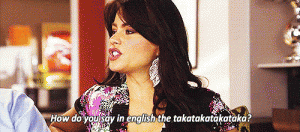
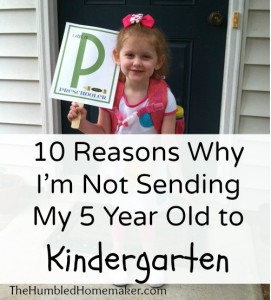
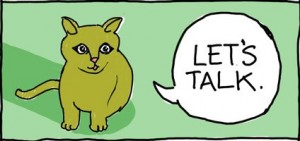

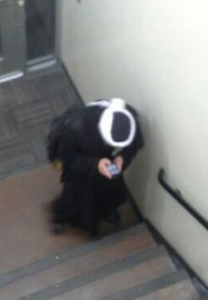




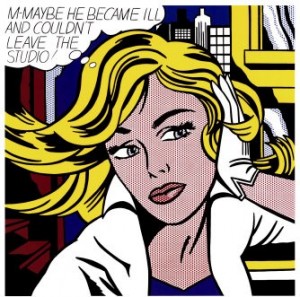
 D5 Creation
D5 Creation